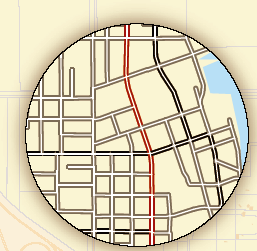In this topic
Transportation network analysis
Transportation involves the movement of people and the shipment of goods from one location to another. The following illustration shows a transportation network:

Streets are a familiar network that you probably traverse every day. A street network is a multilevel network that has a two-way flow except for situations such as one-way streets, divided highways, and transition ramps. While most roads are at surface level, bridges, tunnels, and highway interchanges cross each other in elevation. A simple overpass has two levels and a highway interchange typically has four.
You make your daily travel optimal by moving from one mode of transport to another. That is, you can switch between walking, driving, riding a bus or train, and flying. You also use natural hierarchies in the transportation network. Trips of any distance usually begin by driving to the closest freeway on-ramp and proceeding to the off-ramp closest to the destination.
Street, rail, and subway systems have well-defined geometry for the edges of the network, but transportation systems, such as airline routes and shipping lanes have indeterminate, or variable edges with geographic junctions at airports and harbors.
Transportation networks in ArcGIS are modeled as network datasets. Analysis of transportation networks, such as shortest-path discovery, is modeled by ArcGIS Network Analyst extension. If you want to analyze utility or natural resources, see Utility and natural resource network roadmap.
Transportation tasks include the following:
-
Calculating the quickest path between two locations
-
Determining a trade area based on travel time
-
Dispatching the closest ambulance to an accident
-
Finding the best path and sequence to visit customers
-
Routing a fleet of vehicles efficiently
-
Determining the best location for a facility
-
Finding the distance from every origin in a set of origins to every destination in a set of destinations
This analysis can be done using the Network Analyst toolbar in ArcMap. Use this approach if you need to do a single analysis.
Transportation network analysis using geoprocessing
Most of the ArcGIS Network Analyst extension functionality is available via geoprocessing tools. If you need to perform network analysis, determine if you can accomplish your task using geoprocessing. Network analysis tools can be found in the overview of the Network Analyst toolbox (these tools work with the Network Analyst extension).
Transportation network analysis using ArcObjects
All of the underlying objects used by ArcGIS Network Analyst extension in ArcMap are available via ArcObjects. If your geoprocessing does not fit your needs, you can write code against the NetworkAnalyst application programming interface (API) in stand-alone applications, or with custom commands and tools in ArcMap. Some examples of ArcGIS Network Analyst extension functionality that requires ArcObjects work is custom solvers and custom evaluators. For help on determining how to use ArcGIS Network Analyst extension in your workflow, see Programming with ArcGIS Network Analyst extension.
See Also:
About the ArcGIS Network Analyst extension TutorialEssential ArcGIS Network Analyst extension vocabulary
ArcGIS Network Analyst extension Object Model Diagram
ArcGIS Network Analyst extension User Interface Object Model Diagram
What is a network dataset?
How to open a network dataset
Network datasets and geometric networks
Programming with ArcGIS Network Analyst extension
